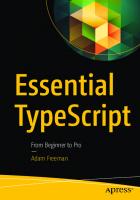Typescript Mini Reference: A Quick Guide to the Typescript Programming Language for Busy Coders: 4
Typescript is a better jаvascript, It is a statically typed, safe programming language, which uses more or less the same
312 61 2MB
English Pages 195 Year 2023
Table of contents :
logo
Hello, Welcome to EPUB Reader
Click button to select your book
Open EPUB book
This Online Web App is made by Neo Reader for experimental purpose, it is a very simple EPUB Reader. We recommend you try our Neo Reader for better experience.
Take a look now
neat reader pc
AD
Ultimate EPUB Reader
Totally free to try
Support multiple file types, such as EPUB, MOBI, AZW3, AZW, PDF and TXT.
Learn more about Neo Reader
General Ebook Solution
Preface
Dear Readers:
1. Introduction
2. Typescript Basics
2.1. What is Typescript?
2.2. Static Typing
2.2.1. Type annotations
2.2.2. Static type checking
2.2.3. Type inference
2.3. Notes on Development Process
2.4. The Typescript Compiler
2.5. Typescript JSON Configuration File
2.5.1. Top-level options
2.5.2. compilerOptions
2.5.3. strict
2.5.4. strictNullChecks
2.5.5. noImplicitAny
2.5.6. noImplicitThis
3. Module System
3.1. ES Modules
3.2. Typescript Modules
3.3. Module Exports
3.3.1. (Regular) exports
3.3.2. Default exports
3.4. Module Imports
3.4.1. Module import
3.4.2. import - from Declaration
3.4.3. Default import
3.4.4. Name list import
3.4.5. Namespace import
3.5. Typescript Namespaces
4. Variables
4.1. The const Declaration
4.2. The let Declaration
4.3. The var Declaration
5. Basic Types
5.1. Javascript Types
5.1.1. The typeof operator
5.1.2. The instanceof operator
5.2. Strict Equality
5.3. Primitive Types
5.3.1. The boolean, number, and string types
5.3.2. The bigint Type
5.3.3. The symbol type
5.4. Literal Types
5.5. The any Type
5.6. The unknown Type
5.7. The null and undefined Types
5.8. The never Type
5.9. The void Type
5.10. The object Type
5.11. Function Types
5.12. Array Types
5.13. Tuple Types
5.14. Enum Types
6. Type Aliases
7. Type Annotations
7.1. Variable Annotations
7.2. Function Annotations
8. Assertions
8.1. Type Assertions
8.2. Const Assertions
8.3. Non-Null Assertions
9. Generics
9.1. Why Generics?
9.2. Generic Functions
9.3. Generic Types
9.4. Generic Type Constraints
10. Arrays
10.1. Generic Array
10.1.1. Array creation
10.1.2. Array iteration
10.2. Generic ReadonlyArray
11. Algebraic Data Types
11.1. Tuples
11.1.1. Fixed-size tuples
11.1.2. Generic tuples
11.1.3. Variadic tuples
11.2. Readonly Tuples
11.3. Union Types
11.3.1. Narrowing
11.4. Discriminated Unions
11.5. Intersection Types
12. Function Types
12.1. Function Definitions
12.2. Arrow Function Definitions
12.3. Function Types
12.3.1. Function type expressions
12.3.2. Function return types
12.3.3. Generic function alias
12.3.4. The Function type
12.4. Parameter List
12.4.1. Parameter initializers
12.5. Optional Parameters
12.6. The Rest Parameter
12.7. Parameter Destructuring
12.8. The this Parameter
12.8.1. Global context
12.8.2. Function context
12.9. Typescript Function Overloading
12.9.1. Overload signatures vs the implementation signature
13. Object Types
13.1. Object Literal Types
13.1.1. The empty object literal type
13.2. Object Type Members
13.2.1. Optional properties
13.2.2. Readonly properties
13.3. Index Signatures
13.3.1. Typescript index signatures
13.4. Getters and Setters
13.5. Member Methods
13.5.1. Method overloading
13.6. Structural Subtyping
14. Interfaces
14.1. Interface Types
14.2. Extending Interfaces
15. Classes
15.1. The ECMAScript Class
15.1.1. Class declaration
15.1.2. Class body
15.1.3. Fields
15.1.4. Accessors
15.1.5. Methods
15.1.6. Constructors
15.1.7. Static blocks
15.1.8. Inheritance
15.2. The Typescript Class
15.2.1. Constructors
15.2.2. Member visibility
15.2.3. Parameter properties
15.3. Abstract Classes
15.4. Implementing Interfaces
15.4.1. Implementing multiple interfaces
15.5. Generic Classes
16. Type Narrowing
16.1. Control Flow Analysis
16.2. The typeof Type Guard
16.3. The instanceof Type Guard
16.4. The in Operator Narrowing
16.5. Discriminated Unions
17. Advanced Types
17.1. Template Literal Types
17.2. The typeof Type Operator
17.3. The keyof Type Operator
17.4. Indexed Access Types
17.5. Conditional Types
17.6. Mapped Types
Appendix A: How to Use This Book
About the Author
About the Series
Community Support
logo
Hello, Welcome to EPUB Reader
Click button to select your book
Open EPUB book
This Online Web App is made by Neo Reader for experimental purpose, it is a very simple EPUB Reader. We recommend you try our Neo Reader for better experience.
Take a look now
neat reader pc
AD
Ultimate EPUB Reader
Totally free to try
Support multiple file types, such as EPUB, MOBI, AZW3, AZW, PDF and TXT.
Learn more about Neo Reader
General Ebook Solution
Preface
Dear Readers:
1. Introduction
2. Typescript Basics
2.1. What is Typescript?
2.2. Static Typing
2.2.1. Type annotations
2.2.2. Static type checking
2.2.3. Type inference
2.3. Notes on Development Process
2.4. The Typescript Compiler
2.5. Typescript JSON Configuration File
2.5.1. Top-level options
2.5.2. compilerOptions
2.5.3. strict
2.5.4. strictNullChecks
2.5.5. noImplicitAny
2.5.6. noImplicitThis
3. Module System
3.1. ES Modules
3.2. Typescript Modules
3.3. Module Exports
3.3.1. (Regular) exports
3.3.2. Default exports
3.4. Module Imports
3.4.1. Module import
3.4.2. import - from Declaration
3.4.3. Default import
3.4.4. Name list import
3.4.5. Namespace import
3.5. Typescript Namespaces
4. Variables
4.1. The const Declaration
4.2. The let Declaration
4.3. The var Declaration
5. Basic Types
5.1. Javascript Types
5.1.1. The typeof operator
5.1.2. The instanceof operator
5.2. Strict Equality
5.3. Primitive Types
5.3.1. The boolean, number, and string types
5.3.2. The bigint Type
5.3.3. The symbol type
5.4. Literal Types
5.5. The any Type
5.6. The unknown Type
5.7. The null and undefined Types
5.8. The never Type
5.9. The void Type
5.10. The object Type
5.11. Function Types
5.12. Array Types
5.13. Tuple Types
5.14. Enum Types
6. Type Aliases
7. Type Annotations
7.1. Variable Annotations
7.2. Function Annotations
8. Assertions
8.1. Type Assertions
8.2. Const Assertions
8.3. Non-Null Assertions
9. Generics
9.1. Why Generics?
9.2. Generic Functions
9.3. Generic Types
9.4. Generic Type Constraints
10. Arrays
10.1. Generic Array
10.1.1. Array creation
10.1.2. Array iteration
10.2. Generic ReadonlyArray
11. Algebraic Data Types
11.1. Tuples
11.1.1. Fixed-size tuples
11.1.2. Generic tuples
11.1.3. Variadic tuples
11.2. Readonly Tuples
11.3. Union Types
11.3.1. Narrowing
11.4. Discriminated Unions
11.5. Intersection Types
12. Function Types
12.1. Function Definitions
12.2. Arrow Function Definitions
12.3. Function Types
12.3.1. Function type expressions
12.3.2. Function return types
12.3.3. Generic function alias
12.3.4. The Function type
12.4. Parameter List
12.4.1. Parameter initializers
12.5. Optional Parameters
12.6. The Rest Parameter
12.7. Parameter Destructuring
12.8. The this Parameter
12.8.1. Global context
12.8.2. Function context
12.9. Typescript Function Overloading
12.9.1. Overload signatures vs the implementation signature
13. Object Types
13.1. Object Literal Types
13.1.1. The empty object literal type
13.2. Object Type Members
13.2.1. Optional properties
13.2.2. Readonly properties
13.3. Index Signatures
13.3.1. Typescript index signatures
13.4. Getters and Setters
13.5. Member Methods
13.5.1. Method overloading
13.6. Structural Subtyping
14. Interfaces
14.1. Interface Types
14.2. Extending Interfaces
15. Classes
15.1. The ECMAScript Class
15.1.1. Class declaration
15.1.2. Class body
15.1.3. Fields
15.1.4. Accessors
15.1.5. Methods
15.1.6. Constructors
15.1.7. Static blocks
15.1.8. Inheritance
15.2. The Typescript Class
15.2.1. Constructors
15.2.2. Member visibility
15.2.3. Parameter properties
15.3. Abstract Classes
15.4. Implementing Interfaces
15.4.1. Implementing multiple interfaces
15.5. Generic Classes
16. Type Narrowing
16.1. Control Flow Analysis
16.2. The typeof Type Guard
16.3. The instanceof Type Guard
16.4. The in Operator Narrowing
16.5. Discriminated Unions
17. Advanced Types
17.1. Template Literal Types
17.2. The typeof Type Operator
17.3. The keyof Type Operator
17.4. Indexed Access Types
17.5. Conditional Types
17.6. Mapped Types
Appendix A: How to Use This Book
About the Author
About the Series
Community Support

![Mastering TypeScript : A Comprehensive Guide to Modern JavaScript Development with TypeScript [1 ed.]
9798223673965](https://ebin.pub/img/200x200/mastering-typescript-a-comprehensive-guide-to-modern-javascript-development-with-typescript-1nbsped-9798223673965.jpg)



![Hands-On Functional Programming with TypeScript: Explore functional and reactive programming to create robust and testable TypeScript applicatons [1 Edition]
9781788831437](https://ebin.pub/img/200x200/hands-on-functional-programming-with-typescript-explore-functional-and-reactive-programming-to-create-robust-and-testable-typescript-applicatons-1-edition-9781788831437.jpg)




